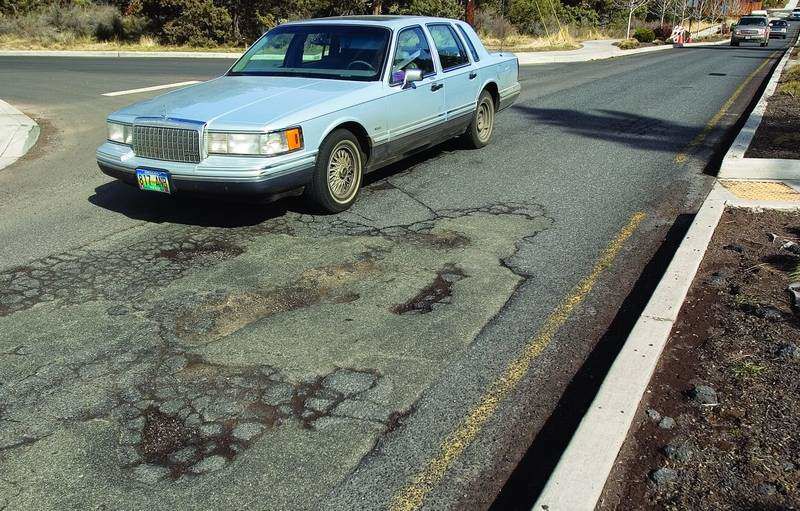Bumps in the road
Published 4:00 am Saturday, March 25, 2006

- A driver attempts to dodge potholes Friday on Reed Market Road near the intersection with Chamberlain Street. City street crews kicked off a busy season of pothole repair Monday.
A cluster of more than a half-dozen craters and a spider web of cracks mar the surface of Reed Market Road at Chamberlain Street on the south side of Bend, making the trip west a little bumpier for drivers.
While that section of Reed Market Road is the worst offender, according to Brandon Raz, Bend street supervisor, a wet winter has created potholes on many streets throughout the city.
”It’s not the worst I’ve seen the streets come out of winter, but it’s definitely the worst I’ve seen in the past couple years,” Raz said.
A five-person crew began patching holes Monday on Greenwood Avenue and the east end of Reed Market Road, Raz said, kicking off a season of road repair that will last into November.
Potholes
Continued from A1
The coming of spring brings road crews out, to repaint stripes, clean up debris and fix the holes that plague drivers.
Temporary patch jobs made during the winter will be ground out and redone with more durable, ”hot mix” asphalt, Raz said.
”I know people are going to say, ‘Geez, what’s taking so long?’ We’ve been waiting for the (hot mix) asphalt plants to fire up,” he said, ”and they’ve been waiting for the weather.”
Raz said the crews will focus on fixing holes in arterial streets first before moving on to neighborhood streets.
”Next week, with it being spring break, we’ll jump in around the schools – 27th Street, Penn and Neff, possibly get on Brookswood if we have enough time,” he said.
At the cratered intersection of Reed Market Road and Chamberlain Street, crews will be doing more extensive repair work rather than simply patching the holes, Raz said, resurfacing about 120 to 140 feet of the road.
Crews have already laid down roughly 35 tons of asphalt in their first week, he said. The street division has managed to reduce the amount of material needed by using an ”asphalt recycler” that allows them to save asphalt grindings when they tear up an old road for resurfacing, and turn the grindings into a mix to patch holes.
Potholes are caused by a combination of moisture and temperature extremes during the winter months, Raz said. Temperature swings cause the road surface to expand and contract, cracking the asphalt. Water seeps into the cracks and freezes, widening the cracks, weakening the pavement and eventually creating a pothole.
Studded tires wear grooves into the pavement, but don’t necessarily cause cracks, according to the Oregon Department of Transportation’s Web site. The ruts can provide a place for moisture to collect, however, creating the potential for cracks. The ruts also require the road be periodically resurfaced.
Road composition, such as whether the base is made of natural rock and concrete, and other factors such as tree roots combine with the daily pounding of traffic to aggravate potholes.
”We’re seeing the impact of having more cars on the streets,” Raz said, adding that driving over potholes can cause them to grow.
In addition to creating an unpleasant ride, hitting a pothole can play havoc with car tires.
Ezra Brumbach, assistant manager at Goodyear Auto Car in Bend, said the business tends to see a spike in customers with tire problems during the second half of winter.
”We’ve seen a lot of it, actually, with people with impact breaks or bent wheels,” Brumbach said.
An impact break occurs when tire cords – cords that reinforce the rubber in a tire – snap when the sidewall of a tire hits a pothole or curb, he explained.
”It causes the tire to bulge out,” Brumbach said. ”It pretty much ruins the tire – you’ve got to replace it.”
Although pothole problems account for only a small number of customers, he said, the business has already seen around 15 to 20 people with damaged tires or bent wheels. Replacing a bent wheel is fairly costly, he said.
”Just watch for (potholes),” Brumbach said. ”Because this time a year, there’s quite a few everywhere.”
Raz said drivers also need to be alert for street workers.
”Definitely be aware that now that the weather is warming up and turning for the better, we’ll have (paint) striping crews out, sweepers out, we have crews cleaning out catch basins and dry wells,” he said. ”We would appreciate any effort the public could give us as far as slowing down and being patient.”
Raz said members of the public are also welcome to call in the location of bad holes, in case street crews haven’t spotted them. Bend Public Works can be contacted at 317-3000.
Studded tire notice:
Studded tires are required to be removed from all vehicles as of April 1. They’re only legal in Oregon Nov. 1 through April 1.






